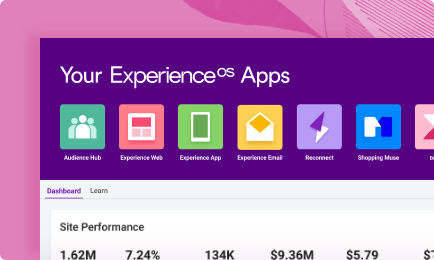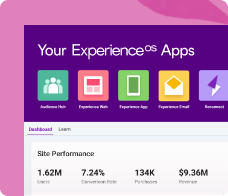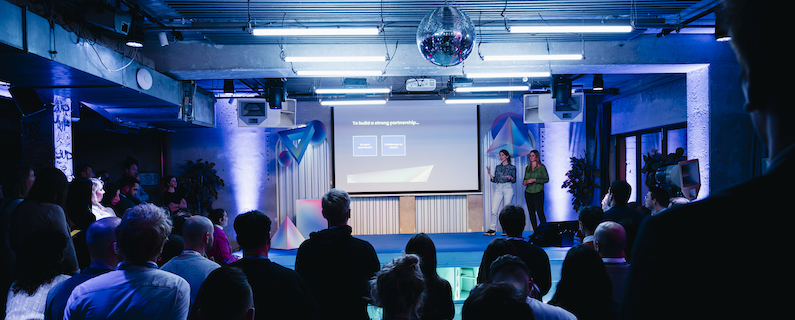The Main Learnings from Personalization Pioneers New York 2023
From strategy and team organization to data feeds and tech stacks, find your program’s edge with the day’s learnings.
On September 21, 2023, global tastemakers and customer experience leaders convened at St. Ann’s Warehouse in Brooklyn to learn and share the latest in innovative testing and personalization strategies at the third Personalization Pioneers event of the year.
If you were unable to attend Personalization Pioneers NYC, fear not: We’ve collected some of the most valuable lessons and insights from the day’s content programming below (as well as via this key learnings report). And be sure to check out the rest of our tour dates and locations to see if you might be able to join us later this fall.
1. The fourth industrial revolution may be driven by AI, but its success is predicated on human input
This year, Ori Bauer, CEO of Dynamic Yield by Mastercard, was planning a family vacation to Umbria, Italy. Wanting to one-up his daughter, who had previously mocked him for using Google rather than TikTok for recommendations the previous year, Ori enlisted Chat-GPT as his personal travel agent. It came up with an Instagram-worthy itinerary that provided detailed, personalized recommendations for every aspect of the trip—lodging, activities, and meals. While the trip looked great on screen, there was one tiny problem: The villas ChatGPT had recommended the family stay in… did not exist. The technology definitely saved Ori time planning the trip, but it wasn’t able to completely substitute all the work of a travel agent.
In his keynote “How to Find Your Personalization Edge,” he reminded attendees that while AI can solve unique problems in the industry and offers the promise of scaling experience delivery and optimization, it’s not a panacea. Just like his itinerary needed human control to elevate the outcome, so does personalization. While AI can be used to predict, adapt and achieve, humans have a responsibility to remain the essential architects of the strategy behind these goals—and the brands that invest in augmenting a solid, human-informed strategy with advanced technology, rather than relying on it or completely shunning it, will be those who win in a time of increased customer acquisition costs and economic uncertainties.

2. Your customers are already telling you what they need with every interaction
Julia Paulsen, Director of eCommerce Nordics at Elkjøp, has always had her sights on “true personalization” for users of the biggest eCommerce site in the region, which generates over 500 million sessions a year: Where elements of the digital experience adjust for the individual or audience. However, while the personalization team at the leading consumer electronics retailer had gotten great at providing product recommendations along the user journey, they still had a long way to go from the program acting as a critical pillar in future-proofing the business. Julia recognized that the brand’s recommendations could be seen as closer to social engineering their customers to make purchases rather than helping them solve problems.
In her keynote “How to Beat the Personalisation Hype and Provide Real Customer Value,” Julia shared that while Elkjøp’s product recommendation strategy was good enough to impact the company’s bottom line, there was still enormous untapped potential in the clues that customers were dropping with every scroll, click, and bounce. All her team had to do was test and measure the impact of various site elements on the user journey.

For example, they created a pop-up to educate customers on a product’s insurance options and tested the headline, copy, and image across their core audiences. They found that while new users preferred seeing all possible insurance options, returning users often bought the same insurance for all products. So once a preference was indicated, the team personalized the pop-up to display only the preferred option going forward.
3. If you’re new to personalization, start with sustainable best practices—your own strategy will emerge organically from here
A $7 billion global brand that redefined how people enjoy coffee at home, Nespresso began its personalization journey two years ago with its US market. In his keynote “Brewing Successful Personalization: A Blend of Strategy and Team Structure,” Ian Bennett, the company’s Senior Digital Commerce Optimization Specialist, discussed how he started the program based on sustainable best practices.
The team started with simple product recommendation modules, A/B testing not design or creative, but algorithms. The team noticed that performance differed by audience and that design and creative could enhance this experience even further. For example, member audiences enjoyed more enhanced designs with in-depth information, while prospects were drawn to more streamlined displays. Building on initial ad hoc tweaks, an omnichannel guided selling roadmap emerged almost naturally, allowing them to target and achieve the largest opportunities.
 4. Let customers lead the way on where and how to incorporate personalized experiences
4. Let customers lead the way on where and how to incorporate personalized experiences
While companies think they can deliver satisfying customer experiences, US consumers beg to differ—with all the devices, platforms, and channels they interact with, they experience an endless amount of brand touchpoints on a daily basis, but don’t always get what they want immediately and in context. In her keynote, “How to Deliver Personalization That Your Customers Really Want,” Jessica Liu, Principal Analyst at Forrester, said that there is a large opportunity for companies to win in these moments across the customer lifecycle by using personalization to frame, guide, extend, and enhance interactions based on a person’s history, preferences, context, and intent.
For example, the earlier in the customer relationship, less individualized messaging will work until the relationship matures, whereas customers will be more receptive to more personalization the longer they’ve interacted with the brand—and the more winning personalized interactions create loyalty. Think about it like dating: You’d most likely scare a potential partner if you dropped intimate details into the conversation on a date, but you’d expect a long-term partner to cater to your needs and preferences within every interaction, and if they didn’t, you’d probably end things.

For a balanced, sustainable personalization program, let this strategy lead which data and tech stack you use to personalize the type of moment—not just your company’s perspective.
5. Evangelization of results is just as important as running your A/B tests
All Pioneering speakers were in agreement on one thing: A personalization program is only as good as its advocates. The most important thing to add to your testing roadmap is opportunities for visibility and collaboration—whether it’s a shared project calendar, standing meeting, or regularly sent findings report.
For Julia Paulsen at Elkjøp, evangelizing the results of A/B tests allowed her team to gain the organizational support to reprioritize their investments to focus on high-impact areas, testing different contexts and content to see which best helped the individual customer advance towards the right products–a step closer to their goal of true personalization.
Ian Bennett from Nespresso found the impact of personalization evangelization also followed this natural path: While it started as an add-on, with every test, it has become an essential business function. There’s a central calendar for projects as well as a regular forum to share test hypotheses and results across the business—all of which are considered at the beginning of all processes.
And during a panel discussion on the topic of operating models, Al Lee, VP of Digital & Technology at JM Bullion, shared that his core team started with just two members, but by prioritizing monthly updates with executive management, they were able to gain engagement and buy-in to expand the program to where it is today: impacting $2 billion in revenue a year. On the same panel, Ann Marie Ippoliti, VP of Digital eCommerce at Michael Kors, said that daily business updates have highlighted data-driven, brand-appropriate opportunities and opened collaboration for integrating the newer business function in additional high-impact legacy areas.
Join us on our next stop
Personalization Pioneers is still touring! If you want to sit in for a deeper understanding of the latest trends, next-level tactics, high-impact use cases and methodologies, and make meaningful connections with other pioneers who live and breathe personalization, we’d love to have you.
Here’s where we’re heading next:
Berlin – 25-26 Oct 2023 (Join the waitlist)
Singapore – 1 Nov 2023 (Sign up here)















